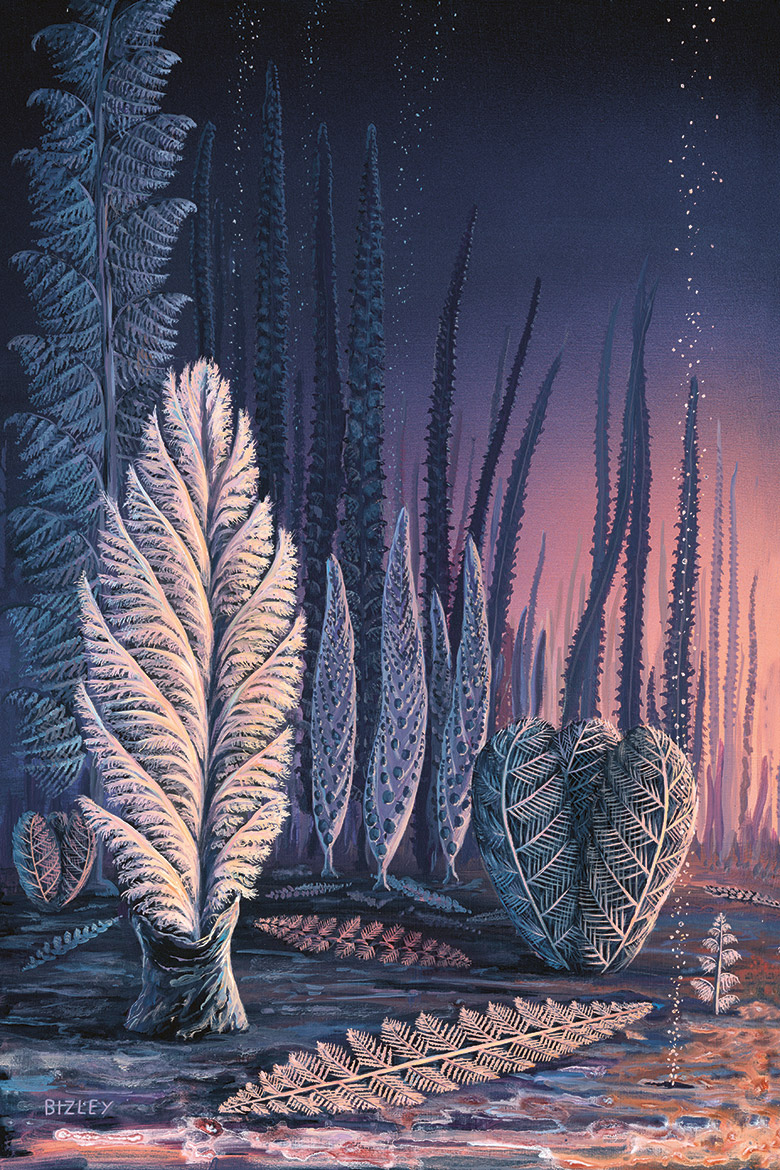Multicellular creatures
When animals once were ferns
What might well be the oldest extant traces of complex, multicellular animals lie in the Ural Mountains. Volcanic ash is now enabling scientists to date them precisely. This in turn is revealing more and more about life in the Ediacaran Period, calling previous hypotheses into doubt.

The seas might have looked like this, 635 million years ago. | Photo: Science Photo Library / Keystone
For a long time, evolution was perfectly content with single-celled life. In fact, for three-and-a-half billion years, our planet was colonised only by microorganisms such as algae and bacteria. Then, within just a few million years – no more than a blink of an eye in geological terms – the first multicellular animals emerged.
They lived in the water and were soft, devoid of any skeleton. Their shapes are reminiscent of jellyfish, tubes, leaves, feathers or ferns. Despite disappearing again without any really recognisable connection to the species of today, they are of great interest from the perspective of evolutionary biology, as the geologist Fred Bowyer from the University of Edinburgh says: “If we succeed in clarifying the causal relationships between the emergence of this first fauna on Earth and the environmental changes at that time, then we might be able to solve one of the greatest mysteries of all: How does complex life arise?”
A mysterious time only gained official recognition as a geological period in 2004: the Ediacaran. It began 635 million years ago, lasted around 100 million years, and ended with the better-known Cambrian Period, when modern animal phyla were already in existence. “Fossil finds in sedimentary rock have long indicated the presence of Pre-Cambrian, multicellular animals”, says Bowyers, “but it was hardly possible to situate them in the chronology of the Earth’s history or to assign them with any reliability to any animal phylogenetic trees”.
Even dating the fauna of the Ediacaran has been imprecise until now. One reason for this is that most organisms back then had no hard parts, meaning that it required extraordinary circumstances for their physical imprints or other traces to be preserved. And it’s only since newer methods have emerged that researchers have been able to use old sedimentary layers to deduce the chemical composition of the water and the air back then. “Today, however, we have a much better idea of the geological processes that took place during the Ediacaran”, says Bowyer. Immediately before the Ediacaran, our planet experienced several cycles with global ice ages during which it was almost completely covered by ice and snow. Then a less pronounced ice age came about, during which the concentration of oxygen in the atmosphere increased.
The most common hypothesis states that, while the surface of the planet was undergoing all these intense changes, constant environmental conditions prevailed only in the depths of the oceans – and that it was there that multicellular life developed. So it seems logical that the oldest traces of multicellular animals ever found to date were in the sediments of deep-sea deposits in Newfoundland in Canada.
Origins in coastal waters after all?
However, new, as yet unpublished findings by the geochronologist Maria Ovtcharova and her research group at the University of Geneva are now calling this hypothesis into question. They have been able to date traces of multicellular animals in a series of samples from the Ural Mountains in Russia. To be more precise: they have determined the age of layers of ash from volcanic eruptions that sandwich rock, fossils and organic material between them.
Ovtcharova and her team date these samples by looking at the decay of the chemical element uranium that is bound to the smallest crystals of the mineral zircon. They measure the composition of the uranium isotopes very precisely, which allows them to determine when the crystals were formed, and thereby when the ash was spewed out from the volcano. In this way, they found that the samples they analysed from the Urals were the same age as the oldest extant evidence of complex life from Newfoundland. “This surprised us”, she says, “because it was clear from the very start that our samples originated from shallow waters in what was originally a coastal environment. Until now, everyone assumed that such life forms only developed there several millions of years later”.
The researchers were also able to show that the traces they analysed came from very similar species as those from Newfoundland – in some cases, even the same species. As a result, they now assume that multicellular life either evolved in parallel in both environments, or even – initially – only in shallow waters. “This naturally contradicts the deep-sea hypothesis”, says Ovtcharova, “and suggests instead that the higher oxygen content and the sunlight available in shallow waters were actually necessary for the development of the first complex life forms”.
Ovtcharova’s most recent work is of great importance for her entire field, above and beyond this initial interpretation of her findings, says Bowyer: “Until now, people had only analysed the samples and fossils from Newfoundland sufficiently to be able to draw conclusions about different factors such as the composition of the fossil community or changes in the oxygen content in the deep sea”, he says. “Now, for the first-ever time, we have a comparable fossil group of the same age, but from a completely different environment, in shallower water. This gives us a lot more data to use for forming and testing hypotheses”.
A worldwide archive on the ocean floor
The next few years might reveal which hypothesis is correct. Thanks to analytical methods becoming ever more precise, the Ediacaran and its fauna are increasingly attracting the attention of researchers from all manner of disciplines. For example, an international project called Geological Research through Integrated Neoproterozoic Drilling (GRIND) has recently been launched. It drills deep into sediment layers that lie hundreds of metres below the surface at sites across the world, and is producing new samples of unprecedented quality. Its aim is to build up an archive of drill cores that cover a period ranging from roughly one billion years ago, up to the end of the Ediacaran.
Simone Kasemann is a geochemist at the University of Bremen and a member of GRIND. She says: “So far, we’ve basically got individual snapshots from just a few parts of the world”. In their first phase, the researchers have been drilling into layers of the Ediacaran in Namibia, Brazil and China. “These layers contain rich fauna”, says Kasemann, “and the deposits reveal a lot in each case about the environmental conditions that once prevailed at these locations”.
Interested researchers from across the world will get access to the drill cores in order to be able to analyse them from all possible perspectives. But first, GRIND aims to create a point of departure for future research that is of high quality and standardised, with the cores documented and described according to precisely defined criteria. This is especially important with regard to dating, says Ovtcharova, who has already received samples from GRIND as part of another research project. “Do we first see an increase in oxygen, and then the first multicellular animals, or is it the other way round? This is a crucial issue. It’s only accurate and precise dating that can reveal the true history of complex life”.




